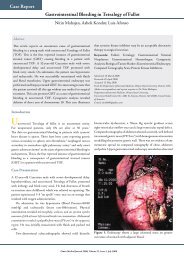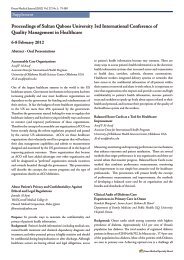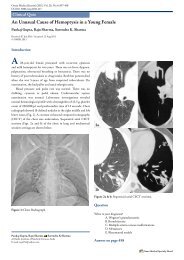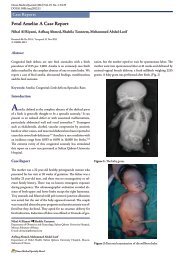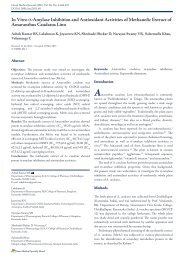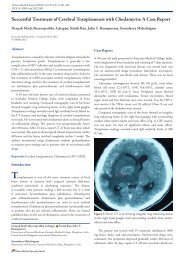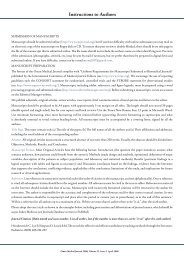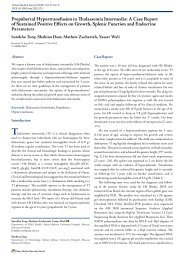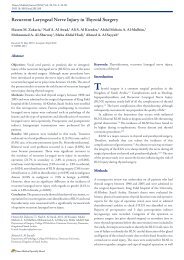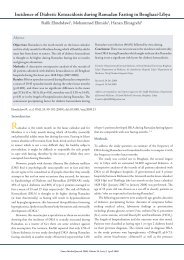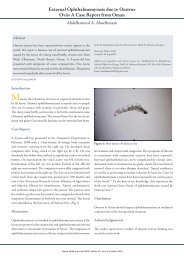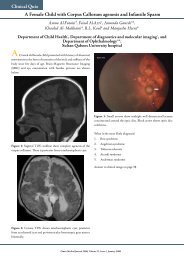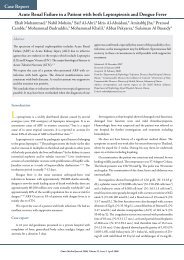Detection of Inborn Errors of Metabolism using Tandem Mass ... - OMJ
Detection of Inborn Errors of Metabolism using Tandem Mass ... - OMJ
Detection of Inborn Errors of Metabolism using Tandem Mass ... - OMJ
Create successful ePaper yourself
Turn your PDF publications into a flip-book with our unique Google optimized e-Paper software.
Oman Medical Journal (2012) Vol. 27, No. 6: 482-485<br />
DOI 10. 5001/omj.2012.115<br />
<strong>Detection</strong> <strong>of</strong> <strong>Inborn</strong> <strong>Errors</strong> <strong>of</strong> <strong>Metabolism</strong> <strong>using</strong> <strong>Tandem</strong> <strong>Mass</strong> Spectrometry<br />
among High-risk Omani Patients<br />
Sulaiman Al Riyami, Matar Al Maney, Surendra Nath Joshi, Riad Bayoumi<br />
Received: 21 Jul 2012 / Accepted: 05 Oct 2012<br />
© OMSB, 2012<br />
Abstract<br />
Objective: This is a report on the types and patterns <strong>of</strong> inborn<br />
errors <strong>of</strong> metabolism (IEMs) <strong>of</strong> amino acids, organic acids and<br />
fatty acids oxidation detected by <strong>Tandem</strong> <strong>Mass</strong> Spectrometry for<br />
a period <strong>of</strong> 10 years (1998-2008) at Sultan Qaboos University<br />
Hospital (SQUH), the major centre for diagnosis and management<br />
<strong>of</strong> IEM in Oman.<br />
Methods: <strong>Tandem</strong> mass spectrometry (MS/MS) was used in the<br />
initial screening and diagnosis <strong>of</strong> IEMs in high risk neonatal and<br />
pediatric populations.<br />
Results: Out <strong>of</strong> 1100 patients investigated, 119 were detected<br />
positive for IEM by MS/MS spectrometry. Twenty six different<br />
metabolic diseases were detected. Patients were categorized into<br />
three major groups: a) 54 with amino acids and urea cycle disorders,<br />
b) 35 with organic acid disorders, and c) 30 with fatty acid oxidation<br />
disorders. The commonest conditions encountered were maple<br />
syrup urine disease (MSUD), phenylketonuria (PKU), propionic<br />
and isovaleric acidurias, as well as HMG-CoA lyase deficiency and<br />
glutaric aciduria type II (GA-II). Most <strong>of</strong> these IEMs were overrepresented<br />
in babies born to consanguineous parents, which is<br />
consistent with the recessive autosomal inheritance.<br />
Conclusion: This study shows that various types <strong>of</strong> IEMs,<br />
reported elsewhere, were also prevalent in Oman, but the pattern<br />
<strong>of</strong> prevalence and distribution is different. The situation, therefore,<br />
warrants the development <strong>of</strong> a nationwide screening and prevention<br />
program.<br />
Keywords: Oman; <strong>Mass</strong> spectrometry; <strong>Inborn</strong> errors.<br />
Abbreviations: ASA: Arigininosuccinic aciduria, BKT:<br />
β-ketothiolase deficiency, BPD-PKU: Biopterin-dependent<br />
phenylketonuria, CPT-I: Carnitine palmitoyl transeferase-I,<br />
EMA: Ethylmalonic aciduria, GA-I: Glutaric aciduria type-I,<br />
Sulaiman Al Riyami, Matar Al Maney<br />
Department <strong>of</strong> Biochemistry<br />
Sultan Qaboos University Hospital,<br />
Muscat, Sultanate <strong>of</strong> Oman.<br />
Surendra Nath Joshi<br />
Sr. Consultant, Department <strong>of</strong> Child Health<br />
Sultan Qaboos University Hospital,<br />
Muscat, Sultanate <strong>of</strong> Oman.<br />
Riad Bayoumi ,<br />
Department <strong>of</strong> Biochemistry,<br />
College <strong>of</strong> Medicine & Health Sciences, Sultan Qaboos University,<br />
P.O.Box- 35, Al Khod, Postal Code 123, Muscat, Sultanate <strong>of</strong> Oman.<br />
E-mail: bayoumi@squ.edu.om<br />
GA-II: Glutaric aciduria type-II, HMG-CoA Lyase: 3-hydroxy-<br />
3-methylglutaryl-CoA lyase deficiency, LCHAD: Long-chain<br />
hydroxyl acyl CoA dehydrogenase deficiency, MCD: Multiple<br />
carboxylase deficiency, MCAD: Medium-chain acyl CoA<br />
dehydrogenase deficiency, MGA: 3-methylglutaconic aciduria,<br />
MMA: Methylmalonic acidemia, MSUD: Maple syrup urine<br />
disease, NKHG: Non-ketotic hyperglycinemia, OTC: Ornithine<br />
transcarbamylase, PGA: Pyroglutamic aciduria, PKU: Classical<br />
Phenylketonuria, PPA: Propionic acidemia, SCHAD: Short-chain<br />
hydroxyacyl CoA dehydrogenase deficiency, VLCAD: Very longchain<br />
acyl CoA dehydrogenase deficiency.<br />
Introduction<br />
<strong>Tandem</strong> mass spectrometry (<strong>of</strong>ten abbreviated as tandem<br />
MS or MS/MS) is considered an important new technology for<br />
neonatal screening and diagnosis <strong>of</strong> inborn errors <strong>of</strong> metabolism<br />
(IEMs). It permits the detection and quantification <strong>of</strong> many IEMs<br />
in a single blood spot for most amino acids, urea cycle disorders,<br />
organic acids and fatty acid oxidation defects. Furthermore, MS/<br />
MS has introduced the concept <strong>of</strong> multiple metabolite analyses<br />
for the detection <strong>of</strong> numerous metabolic disorders in a single<br />
analytical run. 1-3 At present, MS/MS is being used for screening<br />
and diagnosis <strong>of</strong> IEMs in newborns and sick infants in many clinical<br />
biochemical laboratories in the USA, Europe, Australia, Japan, and<br />
other countries. 4-11<br />
SQUH is the main referral hospital for IEMs in Oman. An<br />
organized diagnostic service for IEMs for high-risk babies was<br />
established at SQUH in 1998. During 1998-2002, samples were<br />
tested at King Faisal Specialist Hospital, Saudi Arabia. In 2002,<br />
MS/MS spectrometry was introduced at SQUH. Here, the types<br />
and patterns <strong>of</strong> IEMs encountered at SQUH over a period <strong>of</strong> 10<br />
years (1998-2008) were reviewed. This represents only part <strong>of</strong> the<br />
disease load in a total Omani population <strong>of</strong> 1.6 million people.<br />
Clinical descriptions <strong>of</strong> many <strong>of</strong> these patients were previously<br />
reported. 12-13<br />
Methods<br />
High-risk babies or children from regional hospitals are routinely<br />
referred to the Metabolic Division <strong>of</strong> Child Health Department<br />
at SQUH. A total <strong>of</strong> 1100 patients were referred and investigated<br />
Oman Medical Specialty Board
Oman Medical Journal (2012) Vol. 27, No. 6: 482-485<br />
for inborn errors <strong>of</strong> metabolism during a period <strong>of</strong> 10 years<br />
(1998-2008). Whole blood samples were drawn by heel prick or<br />
venipuncture from high-risk babies and spotted on Guthrie filter<br />
cards No. 903 Whatman paper (Schleicher and Schuell, Dassel,<br />
Germany). Four spots <strong>of</strong> whole blood were collected and allowed<br />
to dry at room temperature for at least three hours. Samples were<br />
then sent to the laboratory in plastic envelopes and stored at 4°C<br />
until analyzed.<br />
In an attempt to reveal the pattern <strong>of</strong> distribution <strong>of</strong> IEMs in<br />
Oman, the geographical location as well as the ethnic and tribal<br />
origin <strong>of</strong> parents was examined. The Omani population was divided<br />
into three ethnic groups: Arabs <strong>of</strong> the north, Arabs <strong>of</strong> the south<br />
(Dh<strong>of</strong>ari), and Omanis <strong>of</strong> Asian descent. Northern Arabs included<br />
all Arab tribes occupying the northern parts <strong>of</strong> Oman. Southern<br />
Arabs included all the Arabs from Dh<strong>of</strong>ar and southern parts <strong>of</strong><br />
Oman. Omanis <strong>of</strong> Asian Origin included migrants from Iran, India,<br />
Pakistan and Afghanistan.<br />
<strong>Mass</strong> spectrometry is a technique used for identifying and<br />
quantifying analytes based on their molecular mass and charge.<br />
For analysis by a mass spectrometer, the analyte <strong>of</strong> interest must<br />
be converted into ions. Ions are separated by electromagnetic fields,<br />
detected by a quantitative method and processed into mass spectra<br />
(Fig. 1) according to their mass to charge ratio (m/z). Therefore,<br />
the main four components <strong>of</strong> MS instrument are sample inlet, ion<br />
source, mass analyzer, and a detector. The vertical axis represents<br />
ion intensity expressed as a % <strong>of</strong> the largest peak in the spectrum.<br />
Internal standards are represented with a small superscript star.<br />
Figure 1: MS/MM spectra <strong>of</strong> amino acids butyl esters <strong>using</strong> an<br />
NL 102 scan. Top Panel: Normal newborn pr<strong>of</strong>ile. Bottom panel:<br />
Pr<strong>of</strong>ile for newborn with Maple Syrup Urine Disease (MSUD).<br />
The horizontal axis represents mass to charge ratio (m/z).<br />
In Electrospray-ionization tandem mass spectrometry (ESI-<br />
MS/MS), a sample is first dissolved in a mixture <strong>of</strong> water and organic<br />
solvent (e.g., acetonatrile). Then, the extract is derivatized with<br />
butanol to form butyl esters <strong>of</strong> amino acids, organic acids, and fatty<br />
acids. As the mass spectrometer cannot detect uncharged molecule,<br />
the analyte must be ionized before it is introduced to the first MS<br />
(MS 1). Ionization <strong>of</strong> the derivatized analyte is achieved by electrospray<br />
ionization in which the sample effluent is passed through a<br />
small capillary to which a high voltage has been applied. The ionization<br />
process involves the transfer <strong>of</strong> a charge to the solvent droplets,<br />
evaporation <strong>of</strong> the solvent, and finally, production <strong>of</strong> positively and<br />
negatively charged ions. This vaporized and ionized mixture enters<br />
the MS 1, which functions as a separating device and allows only the<br />
ion(s) <strong>of</strong> interest to pass through. Ions passing through the MS 1<br />
are called precursor or parent ions. Once the ion passes through the<br />
MS 1, it enters the collision cell where fragmentation takes place.<br />
Fragmentation is typically achieved by introduction <strong>of</strong> an inert<br />
gas such as argon into the collision cell. The fragments generated in<br />
the collision cell are called product or daughter ions. In the second<br />
mass spectrometer (MS2), the product or daughter ions are analyzed<br />
in the same manner as in the first mass spectrometer. Products<br />
or daughter ions in the MS2 can be correlated with the parents ions<br />
produced in the MS 1. This process enables unique mass spectrometry<br />
such as precursor ion scans and neutral loss scans. Since certain<br />
compound classes share common fragment ions <strong>of</strong> neutral fragment<br />
molecules, a special analysis can be set up to only detect precursor<br />
ions with a particular fragment. This results in an ability to measure<br />
only a particular chemical class or subset <strong>of</strong> molecules without detecting<br />
the hundreds <strong>of</strong> molecules that are not <strong>of</strong> interest.<br />
ESI-MS/MS was carried out on a Quattro Micro (Manchester,<br />
UK), triple quadrupole spectrometer, equipped with a Waters<br />
Alliance 2790 HPLC pump, with minor modification <strong>of</strong> methods<br />
developed by Chance et al. 1‐2 and Rashed et al. 3<br />
A 3 mm disk from a selected spot from the Guthrie card was<br />
punched out <strong>using</strong> a standard hole punch in each <strong>of</strong> a 96-well<br />
polypropylene microtitre plate. The sample in the blood spot<br />
punch in each well was then extracted by adding 100 μl <strong>of</strong> isotopelabeled<br />
internal standard solution <strong>of</strong> amino acids and acylcarnitines<br />
(Cambridge Isotope Labs, Andover, MA, USA) and incubated at<br />
room temperature for 30 minutes. The extracted sample was then<br />
transferred to another plate. The solvent was gently evaporated and<br />
60 μl <strong>of</strong> butanolic HCl was added. The plate was sealed with special<br />
heat-resistant tape and heated at 65 o C for 15 minutes. The solvent<br />
was evaporated again and the residue was finally reconstituted in<br />
100 μl <strong>of</strong> the mobile phase (acetonatrile/water, 80/20 v/v) and fed<br />
into the system through the HPLC pump.<br />
Neolynx s<strong>of</strong>tware (Neolynx Inc., Glendale, California, USA)<br />
was used for processing MS/MS data. Neolynx operates by<br />
calculating the ratio <strong>of</strong> the intensity <strong>of</strong> the mass spectral peak for the<br />
analyte to the intensity <strong>of</strong> the mass spectral peak for a pre-defined<br />
internal standard. If the concentration <strong>of</strong> the internal standard is<br />
Oman Medical Specialty Board
Oman Medical Journal (2012) Vol. 27, No. 6: 482-485<br />
known then the concentration <strong>of</strong> the analyte may be calculated by<br />
multiplying the peak intensity ratio by the concentration <strong>of</strong> the<br />
internal standard. Samples were analyzed in duplicates in the same<br />
analytical run. If a sample is flagged as abnormal, a repeat sample for<br />
MS/MS analysis was requested. If the second sample agreed with<br />
the first sample result, the diagnosis was then confirmed by urine<br />
organic acids analysis, plasma amino acids analysis, or direct enzyme<br />
assay; all analyzed by Biomnis laboratory, France (BIOMNIS<br />
Specialised Medical Pathology, International Division, Lyon Cedex<br />
7 – FRANCE).<br />
Results<br />
During the period <strong>of</strong> May 1998 - July 2008, a total <strong>of</strong> 1100 patients<br />
were tested, wherein 119 were positive for an IEM. The important<br />
characteristics <strong>of</strong> the 119 patients with diagnosed IEM are shown in<br />
Table 1. The 119 patients suffered from three main categories <strong>of</strong> IEM,<br />
namely; amino acids and urea cycle defects, organic acid disorders,<br />
and fatty acid oxidation disorders. The 119 patients belonged to 89<br />
different families; as some families had more than one affected child<br />
with the same disorder. Fifty six percent (67/119) <strong>of</strong> the patients<br />
were males and 44% (52/119) were females. Information regarding<br />
family history <strong>of</strong> the same illness or unexplained death was obtained<br />
in 77 patients while consanguinity was confirmed in 73 patients.<br />
It was also observed that symptoms <strong>of</strong> IEMs generally presented<br />
as early as one day or could be delayed for up to eight years <strong>of</strong> life.<br />
Most <strong>of</strong> the patients (86%) were Northern Arabs while 12% were <strong>of</strong><br />
Asian origin. Arabs <strong>of</strong> the south comprised only 2% <strong>of</strong> the studied<br />
population. Furthermore, it was noted that 47% (48/102) <strong>of</strong> the<br />
Northern Arabs and 86% (12/14) <strong>of</strong> the Omanis <strong>of</strong> Asian origin<br />
came from the north coastal region <strong>of</strong> Oman.<br />
Some specific diseases were confined to Arabs from Northern<br />
Oman such as MSUD (17/17), BPD-PKU (3/3), some urea<br />
cycle defects [ASA (4/6) hyperornithinemia (2/2), Citrullinemia<br />
(3/3), OTC deficiency (2/2)], VLCAD (3/3), HMG-CoA lyase<br />
deficiency (9/9), CPT-I deficiency (5/5), and 3-Methylglutaconic<br />
aciduria (2/2). Arabs <strong>of</strong> the North also had a large portion <strong>of</strong><br />
PPA (11/14), IVA (8/10), tyrosinemia type-1 (6/7), classical<br />
homocystinuria (2/3), and GA-II (4/8).<br />
Table 1: Characteristics <strong>of</strong> the 119 Omani neonates, babies<br />
and children with inborn errors <strong>of</strong> metabolism diagnosed at Sultan Qaboos University Hospital during 1998-2008 <strong>using</strong> tandem mass<br />
spectrometry.<br />
Disorder No. <strong>of</strong><br />
Patients<br />
No. <strong>of</strong><br />
Families<br />
Sex<br />
(M/F)<br />
Family History<br />
(Y/N)<br />
Consang<br />
(Y/N)<br />
Onset <strong>of</strong><br />
symptoms<br />
Amino Acids<br />
& Urea Cycle<br />
Disorders<br />
54/119<br />
(45.4%)<br />
Organic Acid<br />
Disorders<br />
35/119<br />
(29.4%)<br />
Fatty Acid<br />
Oxidation Disorders<br />
30/119<br />
(25.2%)<br />
MSUD 17 13 7/10 11/3 11/2 1-30 days<br />
Classic-PKU 8 5 6/2 6/2 6/2 5 day - 4 yrs<br />
Tyrosinemia-I 7 5 5/2 7/0 7/0 2 wks - 6 mos<br />
ASA 6 5 3/3 5/1 6/0 1d - 20 mos<br />
BPD-PKU 3 2 2/1 2/1 3/0 1- 12 days<br />
Citrullinemia 3 3 2/1 3/0 3/0 Day 3 <strong>of</strong> life<br />
NKHG 3 2 ½ 2/0 2/0 Day 1 <strong>of</strong> life<br />
Homocystunuria 3 3 2/1 1/0 1/0 1-3 yrs<br />
Hyperornithinemia 2 2 0/2 2/0 2/0 1- 5 yrs<br />
OTC deficiency 2 2 2/0 1/0 1/0 Day 3 <strong>of</strong> life<br />
Propionic acidemia 14 11 9/5 9/5 11/3 1- 4 days<br />
Isovaleric Acidemia 10 7 3/7 7/2 6/2 1 d - 4 yrs<br />
MMA 5 2 3/2 4/1 3/1 2 days<br />
MGA 2 2 2/0 1/1 1/1 1 d - 2 mos<br />
BKT deficiency 2 2 1/1 1/1 1/1 4 - 12 mos<br />
PGA 1 1 0/1 1/0 1/0 30 days<br />
GA-I 1 1 1/0 -- -- 8 mos<br />
HMG CoA Lyase 9 6 8/1 9/0 7/1 7 d - 2 yrs<br />
deficiency<br />
GA-II 8 4 5/3 7/1 5/3 1d - 15 mos<br />
CPT-I 5 4 1/4 2/3 2/2 2d - 3 yrs<br />
VLCAD 3 2 2/1 3/0 3/0 3 d - 8 yrs<br />
MCAD 1 1 0/1 1/0 1/0 1 yr<br />
LCHAD 1 1 1/0 1/0 1/0 3 yrs<br />
SCHAD 1 1 0/1 -- -- --<br />
EMA 1 1 0/1 -- -- --<br />
MCD 1 1 1/0 -- -- --<br />
Oman Medical Specialty Board
Oman Medical Journal (2012) Vol. 27, No. 6: 482-485<br />
Discussion<br />
In this retrospective study, 119 patients were diagnosed with IEMs<br />
out <strong>of</strong> 1100 high-risk Omani neonates, babies and children during<br />
the period <strong>of</strong> May 1998 to December 2008. Clinical diagnosis was<br />
initially confirmed by a rapid screen <strong>using</strong> MS/MS spectrometry.<br />
The initial pick up rate (1 out <strong>of</strong> 9.2 tests) for MS/MS recorded<br />
here is, therefore, fairly high. The definitive diagnosis was made by<br />
plasma amino acid analysis, urine organic acid analysis or direct<br />
enzyme assays.<br />
The number <strong>of</strong> IEM patients from each <strong>of</strong> the five regions <strong>of</strong><br />
Oman seems to be more or less proportional to the percentage <strong>of</strong><br />
the population in each region; except, Dh<strong>of</strong>ar region, where the<br />
number <strong>of</strong> IEM patients is lower than expected. This is a direct<br />
reflection <strong>of</strong> the small number <strong>of</strong> patients referred from Dh<strong>of</strong>ar; a<br />
geographically distant region <strong>of</strong> Oman.<br />
In this study, IEMs are over-represented in babies born to<br />
consanguineous parents and most patients were found to have a<br />
positive family history <strong>of</strong> an IEM or <strong>of</strong> unexplained death among their<br />
families. These findings are consistent with the recessive autosomal<br />
inheritance <strong>of</strong> IEMs and reflect the significant contribution <strong>of</strong><br />
consanguinity in Oman in this particular health problem. 14 It was<br />
also noticed that many families have more than one affected child<br />
with IEM, which can be attributed to the lack <strong>of</strong> early detection <strong>of</strong><br />
such disorders, as well as the lack <strong>of</strong> parental genetic counseling.<br />
Ignorance about IEMs and the lack <strong>of</strong> specialized healthcare centers<br />
and practitioners in Oman must have further contributed to this<br />
health problem.<br />
The initial symptoms <strong>of</strong> IEMs may appear as early as day one<br />
<strong>of</strong> life. In this study, the onset <strong>of</strong> symptoms ranged from 1 day to 8<br />
years. Early detection and treatment <strong>of</strong> individuals at risk <strong>of</strong> IEMs<br />
before the onset <strong>of</strong> symptoms can prevent or at least, reduce serious<br />
neurological and developmental damage. 15<br />
Conclusion<br />
This retrospective review <strong>of</strong> IEMs at SQUH shows that different<br />
varieties <strong>of</strong> IEMs reported elsewhere were also prevalent in<br />
Omani communities and therefore, warrants the development <strong>of</strong> a<br />
nationwide screening program, as well as a systematic cost-effective<br />
prevention program, 16 similar to those already in place in the<br />
Arabian Gulf countries. 10,17<br />
References<br />
1. Chace DH, Hillman SL, Millington DS, Kahler SG, Roe CR, Naylor EW.<br />
Rapid diagnosis <strong>of</strong> maple syrup urine disease in blood spots from newborns by<br />
tandem mass spectrometry. Clin Chem 1995;41:62-68.<br />
2. Chace DH, Kalas TA, Naylor EW. Use <strong>of</strong> tandem mass spectrometry <strong>of</strong><br />
multianalyte screening <strong>of</strong> dried blood specimens from newborns. Clin Chem<br />
2003;49:1797-1817.<br />
3. Rashed MS, Ozand PT, Bucknall MP, Little D. Diagnosis <strong>of</strong> inborn errors <strong>of</strong><br />
metabolism from blood spots by acylcarnitines and amino acids pr<strong>of</strong>iling <strong>using</strong><br />
automated electrospray tandem mass spectrometry. Pediatr Res 1995;38:324-<br />
331.<br />
4. Ziadeh R, H<strong>of</strong>fman EP, Finegold DN, Hoop RC, Brackett JC, Strauss AW et<br />
al. Medium chan acyl-CoA dehydrogenase deficiency in Pennsylvania: neonatal<br />
screening shows high incidence and unexpected mutation frequencies. Pediatr<br />
Res 1995;37:675-678.<br />
5. Shigematsu Y, Hirano S, Hata I, Tanaka Y, Sudo M, Sakura N et al.<br />
Newborn mass screening and selective screening <strong>using</strong> electrospray tandem<br />
mass spectrometry in Japan. J Chromatogr B Analyt Technol Biomed Life<br />
Sci 2002:776:39-48.<br />
6. Schulze A, Linder M, Kolmuller D, Olgemoller K, Matatepek E, H<strong>of</strong>fmann GF.<br />
Expanded newborn screening for inborn errors <strong>of</strong> metabolism by electrospray<br />
ionization-tandem mass spectrometry: results, outcome, and implications.<br />
Pediatrics 2003;111:1399-1406.<br />
7. Wilcken B, Wiley V, Hammond J, Carpenter K. Screening newborns for<br />
inborn errors <strong>of</strong> metabolism by tandem mass spectrometry. N Engl J Med<br />
2003;348:2304–2312.<br />
8. Pandor A, Eastham J, Beverley C, Chilcott J, Paisley S. Clinical effectiveness<br />
and cost effectiveness <strong>of</strong> neonatal screening for inborn errors <strong>of</strong> metabolism<br />
<strong>using</strong> tandem mass spectrometry: a systematic review. Health Technol Assess<br />
2004;8:1-121.<br />
9. Borrajo GJ. Newborn screening in Latin America at the beginning <strong>of</strong> the 21 st<br />
century. J Inherit Metab Dis 2007;30:466-481.<br />
10. Saddallah AA, Rashed MS. Newborn screening: experiences in the Middle East<br />
and North Africa. J Inherit Metab Dis 2007;30:482-489.<br />
11. Therrel BL, Adams J. Newborn screening in North America. J Inherit Metab<br />
Dis 2007;30:447-465.<br />
12. Joshi SN, Hashim J, Venugopalan P. Pattern <strong>of</strong> inborn errors <strong>of</strong> metabolism in<br />
an Omani population <strong>of</strong> the Arabian Peninsula. Ann Trop Paediatr 2002;22:93-<br />
96.<br />
13. Joshi SN, Venugopalan P. Clinical characteristics <strong>of</strong> neonates with inborn<br />
errors <strong>of</strong> metabolism detected by <strong>Tandem</strong> MS analysis in Oman. Brain Dev<br />
2007;29:543-546.<br />
14. Rajab A, Patton MA. A study <strong>of</strong> consanguinity in the Sultanate <strong>of</strong> Oman. Ann<br />
Hum Biol 2000;27:321-326.<br />
15. American College <strong>of</strong> Medical Genetics. Report on Newborn screening: toward<br />
a uniform screening panel and system. Genet Med 2006;8 Suppl 1:1S-252s.<br />
16. Pollitt RJ, Green A, McCabe CJ Booth A, Cooper NJ, Leonard JV et al.<br />
Neonatal screening for inborn errors <strong>of</strong> metabolism: cost, yield and outcome.<br />
Health Technol Assess 1997;1:1-191.<br />
17. Al-Hosani H, Salah M, Saade D, Osman H, AlZahid J. United Arab Emirates<br />
National Screening Program: an evaluation 1998-2000. East Mediterr Health<br />
J 2003;9:324-332.<br />
Acknowledgements<br />
The authors reported no conflict <strong>of</strong> interest for this work. SAR was<br />
a recipient <strong>of</strong> SQU scholarship for MSc degree. We are grateful for<br />
Mrs. Taruna Dutt for typing the manuscript.<br />
Oman Medical Specialty Board



